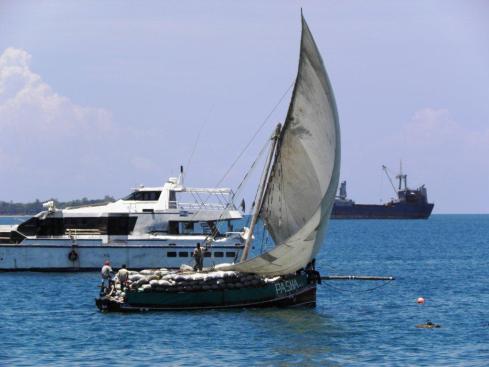These boats – collectively known as dhows – have a history going back to ancient times. In the heyday of the Swahili civilization, the merchants who plied their trade to and fro across the Indian Ocean between the coasts of India and Africa did so in their famous “sewn boats”. The hulls of these vessels were made of planks of coconut wood sewn together with coarse fibers rather than attached with metal nails.
The distinctive lateen sails of the dhow differed both from the European and Chinese models, and were originally made from palm leaves. The building of a new dhow was – and to some
extent is – a grand event. The process of building a large dhow could take years and required the skill of a master craftsman. When the dhow was ready to be launched, an imam arrived to preside over the ceremony and recite verses from the Koran at a feast attended by the whole village. Talismans and charms were hung from the prow to foil the evil spirits that lurked in the sea, ready to drag a shop down to their lairs.
The dhow building continues to be a revered art form in Zanzibar today, passed down through generations from father to son. Dhow craftsmen can be visited at their beachside workshops in Marahubi and Nungwi where these massive cargo ships are constructed. The web of trade and settlement encompassed the whole Indian Ocean, from the Arabian coast to inner Africa in one directions and South East Asia in the other. At Zanzibar the dhow took on three school teachers whom Villiers describes as Swahili.
For several thousand years the dhow has circulated around the Indian Ocean, transporting goods and conveying people, creating a cosmopolitan maritime culture. While trade was the primary rationale, a great variety of people moved with it across the oceans; sailors, merchants and settlers, and in the former days there were also slaves, religious refugees, and conquerors. Dhows played a critical role in the trade of Zanzibar, transporting goods between various regions around the Western Indian Ocean. One of the major commodities of trade was ivory, transported by human porters from the interior of Africa. During the lull between the two monsoon seasons they were careened in the Darajani Creek.
By the early 1960’s, the dhow trade to Zanzibar had begun to falter as a result of the discovery of oil in the Persian Gulf, and the Zanzibar Revolution in 1964 dealt a fatal blow to this ancient trade. But several millennia of the dhow trade have left a rich residue of cultural unity that has acquired its own momentum.
There is a permanent exhibition at the House of Wonders: the Mtepe, an ancient Swahili vessel, sails again. The mtepe was a unique Swahili vessel that used to sail in East African waters until the 1930s. It was one of the last survivors of a type of boats in which no iron nails were used. Instead, the planks were sewn with coir fiber and fastened to the ribs by wooden pegs. One of the earliest references to such method of construction occurs in the Periplus, a Greek commercial guide of the 1st century AD.
This was a common method of dhow construction in the Indian Ocean before the coming of the Europeans in the 16th century. Nevertheless these vessels were strong enough to sail all the way to China during the Middle Ages, as the similarly built Omani vessel, the Sohar, did in 1982. Some of them were quite large. One mtepe in the 19th century was nearly 30 metres long with a tonnage of 186 tons.
There are a lot stories why these vessels were sewn. Some believed magnetic mountains in the ocean would pull out the iron nails or the whole vessel to its submarine doom. Others thought iron was too expensive and would easily rust in the salty sea. It is more likely that the raw materials, wood and coir rope, were easily available in the Indian Ocean, and sewn vessels were more pliable than the stiff nailed ones, and less likely to break up on the coral-infested shores.
The metepe carried a square matting sail which was plaited from the fiber of the wild date palm, rather than the lateen sail that has now become the trademark of Indian Ocean dhows.
It carried cattle, salt, food grains, firewood, mangrove poles, and formerly slaves as well. Some of these ships weighed as much as 40 or 50 tons, and their hold carried unimaginably lavish cargos of ivory, gold, spices, silks and slaves.
A special show not to be missed: in July the Dhow races start in the Zanzibar Harbor.
Dhow-building and harbour activity: as well as being a tourist destination, Nungwi is also the centre of Zanzibar’s traditional dhow-building industry. A number of hardwood trees, particularly good for boats, grow in this area (or at least did grow here, until they were chopped down to make into boats). Generations of skilled craftsmen have worked on the beach outside the village, turning planks of wood into strong ocean-going vessels, using only the simplest of tools. It is a fascinating place to see dhows in various stages of construction.








Leave a comment